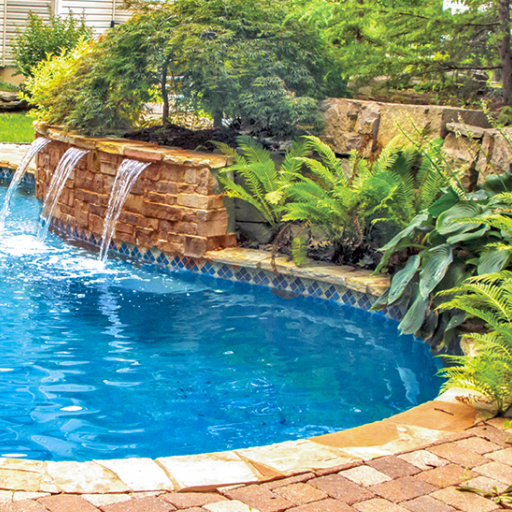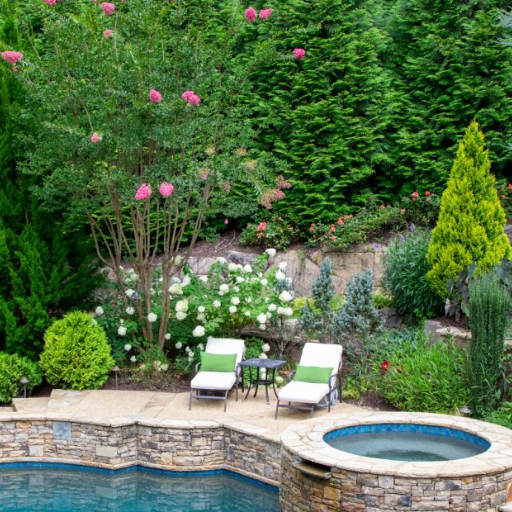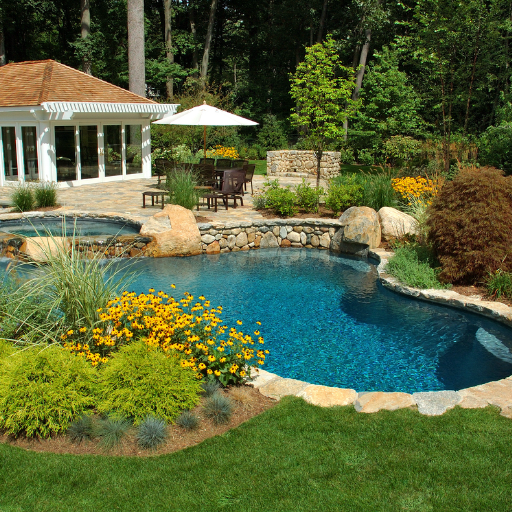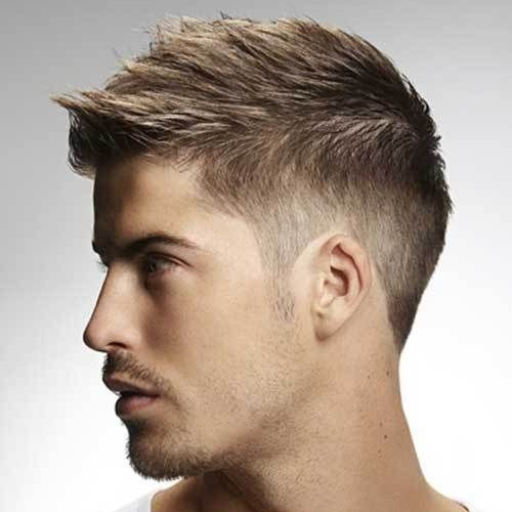Creating a visually beautiful and relaxing terrace goes beyond the pool itself. It is about creating a harmonious environment in which to enjoy the pool experience. Planting pots and landscaping around the swimming pool lends some greenery, elegance, and functionality to the surroundings. Therefore, this article peeks into ideas on selecting ideal poolside plants, placing pots strategically, and designing a balanced poolside landscape compatible with the owner’s personality, requiring as little upkeep as possible. These hints will assist you in turning the pool area into a real paradise, whether you want plenty of green foliage, multicolored flowers, or just a smattering of useful greenery.
Choosing the Best Poolside Plants

In choosing great poolside plants for your poolside location, the climate, exposure to the sun, maintenance, and attractiveness must be considered. Select for your climate and for the sunlight situation of the space-site. Some plants that deal well with neglect and that provide a bold visual impact include succulents and grasses, or tropical plants like palm trees and birds of paradise. One should also consider selecting non-invasive plants that shed minimally so as to keep their pool area clean and hassle-free. To give some extra colors, potted flowers such as hibiscus or bougainvillea might just be the thing, as they will provide enough color but will not overload your space or demand too much work.
Top Potted Plants for Pool Areas
In choosing pool area potted plants, one should walk the fine line between beauty, practicality, and maintenance. Based on what connoisseurs say:
Hibiscus-When it comes to tropical flowers, they are a perfect choice for the poolside setting. They add plenty of colors and energy to the space and like full sun. Therefore, they would be perfect around a sunny pool. Water them moderately and prune when needed to keep them looking great.
Bougainvillea-Having colors that stand boldly from the crowd, bougainvillea is a perfect pool area low-maintenance-type design. It prefers full sun and minimal watering from establishment, with its cascading growth adding a nice touch to your outside oasis.
Crotons-If foliage comes first to your list of desires, crotons are a good choice. Their brilliant, multicolored leaves inject movement into the poolside decor. Position them in the sun and keep the soil moist for the best show.
The trade-off of choosing these potted plants for your pool area is that it will be easy to maintain so that you can just relax and enjoy your outdoor retreat.
Considerations for Plant Selection Around Pools
When selecting plants for around the pool, I focus on a few factors to ensure practicality and aesthetic appeal. First, I look for plants that are low-maintenance and tolerant of sunny, humid conditions common near pools. Next, I try to avoid plants that shed excessively (such as many deciduous trees), because they tend to drop debris into the water and on the pool deck. I also use some common-sense safety considerations, avoiding plants with sharp edges or thorns, toxic plants, along with any that have invasive root systems that might damage hardscape around the pool. Finally, I try to balance this practical consideration for durability with aesthetic appeal, choosing plants that complement the design of the pool while creating a lush, inviting atmosphere.
Ideal Ornamental Plants for Poolside Landscaping
When selecting ornamental plants for landscaping around the pool, I aim for a mix of low-maintenance and no-shedding, yet they must look good. Ornamental grasses, like fountain grass and muhly grass, offer an airy elegance coupled with minimal upkeep. Succulents such as agave or echeveria also fit the bill: they grow in sunny conditions, don’t shed leaves, and have shallow root systems. For a more tropical vibe, I prefer compact palm varieties such as the pygmy date palm, which is tall and textured without creating a mess. Plants in colors, such as hibiscus or bird of paradise, provide bright blooms to the pool area, both of which are hardy enough for poolside conditions. Basically, I want plants that fulfill both function and beauty, so that both spaces can be functional and visually inviting.
Landscaping Ideas for Your Pool Area

While designing your pool area landscaping, start with plants that are low-maintenance and environmentally friendly. Opt for greenery like succulents or ornamental grass, which need very little watering and grow well in full sun. To keep things interesting, insert a few hardy flowering plants, such as hibiscus or bougainvillea, to sprinkle some vibrant colors that harmonize with the tropical feel. For some shade and privacy, thin palms-like pygmy date palm or bamboo can frame your area without becoming bulky. When landscaping, consider the cleanup of foliage and debris by steering clear of trees with invasive roots or those that shed enormous leaves. For greater utility, include paths or potted plants to keep the area clean and accessible.
Incorporating Grass and Ground Cover
Grass and ground covering should be as practical as they are beautiful for your poolside landscape. Beginner-foot traffic zones warrant hard-wearing, low-maintenance grasses such as Bermuda or Zoysia, which like it sunny and recover fast. If this is one area you do not want to mow, the likes of creeping thyme or dichondra would make an attractive and durable groundcover option. For shade, moss patches or Asiatic jasmine are worth considering. Use edging or stepping stones to divert foot traffic away from these surfaces and maintain cohesiveness. By cleverly melding grass and ground cover, one can complement a lush, welcoming poolside space with functional appeal.
Designing with Shrubs and Perennials
When working with shrubs and perennials, I attempt to create balanced and visually pleasing landscapes. Shrubs that usually provide structure with interest throughout the year, such as boxwoods or hydrangeas, nicely frame a space. Perennials I select bloom at various times of the year, including daylilies, coneflowers, or salvia, so there is some color and texture being contributed to the scene all the time. In general, I like to layer plants by height with the taller shrubs or perennials in the back and shorter ones in the front to give some depth and dimension. Also, I pay attention to sun, soil, and water needs for each plant so they are able to co-exist well with a very low level of maintenance. As such, design results in a vibrant and well-balanced poolside landscape that feels a little bit structured but quite natural.
Creative Uses of Planters Around the Pool
Planters are a very flexible design element, which can be used to improve both the look and the functionality of a poolside area. Tall planters with structured plants such as bamboo or ornamental grasses can be used to maintain privacy without imposing an oppressive atmosphere. To really set the exterior décor off with color, a nice splash of vibrant flowering plants grouped in matching pots works wonders. These grouped planters of various heights create a great contrast in color and depth, particularly in the corner areas or down a side route. To avoid design contradictions, share planter materials with other poolside elements such as furniture or tiles. And, in favor of functionality, lightweight planters finish the job while weather resistance will determine how often the planters will have to be repositioned. Such thoughtful use of planters transforms the entire poolside and provides the versatility to refresh the look quicker on occasion.
Highlighting Tropical and Exotic Plants

A frenzy of colors is reflected in any plants that are planted at the poolside. Popular varieties include lush palms, bird of paradise, and hibiscus for attractive foliage and color splashes. These plants nurture themselves in a warm, moist atmosphere and may perfectly be teamed with colorful, eye-catching planters. To ensure a good growth period, one must also look into the light exposure and water needs of each plant. Besides increasing the attractiveness of the area, these plants greatly enhance the tranquility of the setting to create a resort-like oasis.
Hibiscus and Bird of Paradise as Poolside Features
Hibiscus and bird of paradise plants, very vibrant and surely great for a tropical vibe, have become my favorites for poolside features over the years. From my observations, hibiscus shrubs flourish well in sunny areas where there is well-draining soil and regular watering, with the plants bringing stunning red, yellow, pink, or white blossoms to life. Likewise, the bird of paradise, with its famous orange and blue flower that looks like a bird in flight, prefers lots of direct sunlight and soil that’s kept a little moist. When it comes to taking care of these plants, they’d much appreciate being sheltered from any fierce winds and having some balanced fertilizer applied during their active growing seasons. These choices allow me to keep a lush resort-style ambience, plus have low-maintenance yet attractive greenery by my pool.
Eye-Catching Banana Trees and Canna Flowers
Banana trees are an essential component of my poolside landscape design, their tall stature and giant leaves offering a tropical backdrop with much drama. They grow best in full sun and soils consistently moist but well-drained. To highlight their devastatingly bold presence, I’ve planted canna flowers to provide the backdrop with vibrant blossoms of red, yellow, and orange. These plants require watering, a little fertilizing, and cutting back at the end of their growing season to encourage healthy new growth; hence, I attend to these plants regularly, together with the banana trees. So green and ever-dynamic, banana trees and canna flowers instantly uplift my outdoor space, casting upon it the essence of a resort.
Adding Drama with Brugmansia and Elephant Ears
The garden’s dramatic element has been raised with the addition of Brugmansia and Elephant Ears. Brugmansia with its trumpet-shaped flowers, presents a cascade of blooms that become fragrant, especially in the evenings. I have planted them near the seating area to enjoy the scent on many a half-time outdoor evening.
In contrast, the big leafy sheets of comfort present by the Elephant Ears provide a more tropical feel, giving a contrasting texture to the whole garden spirit. These grow best in semi-shaded spots with a steady supply of moisture, further providing the balance of height and structure. With the combined presence of these two unique species, my garden becomes an immersive experience that is rich with life, while effortlessly capturing those vibrant and dynamic, resort-like vibes.
Maintaining a Beautiful Poolside Landscape

Caring for a poolside beautiful landscape involves fine-tuning every step. Start watering the plants during the warmer months and prune them regularly to maintain shape and prevent overgrowth. Choose plants with little maintenance needs that test well with the locale while working in tandem with the poolside environment. Avoid plants that shed obnoxiously on the pool surface. Mulch is a great addition around the base of plants to conserve moisture and keep down weeds. Regular washing of the hardscape area, including patios or pathways, prevents dirt buildup and enriches the feel of the landscape. With steady upkeep, the poolside area remains a lush and inviting sanctuary all year round.
Seasonal Care for Pool Plants
Correct care for pool plants depends on each season, and by customizing your care, the plants are assured of good health and vibrant display throughout. In spring, prune overgrown plants, lay fresh mulch, and keep a watch for any pest or disease occurrences that may have cropped up during winter. In the summer, while keeping plants watered through dry spells of very bright sunlight, do so moderately, as overwatering could lead to root rot. Another option is adding shade-tolerant plants to protect more vulnerable ones from the harsh sun. Autumn becomes the best time for cleaning fallen leaves and debris, for they quickly accumulate and degrade soil health. During winter, cover up delicate plants against frost or relocate potted plants into sheltered places. Adopting such adjustments with every change of season keeps your poolside landscape buoyant and presentable throughout the year.
Managing Water and Sunlight for Optimal Growth
Water and sunlight management involve paying attention to what my plants need. First, I do research dealing with their respective needs. I water deeply and less often, encouraging deep root growth and adjusting watering times as the seasons change so that plants are well-thirsted but not waterlogged. I expose sun-loving species to full sunlight or give partial shade to those that prefer less intense light. By noticing how my plants react to these alterations, I heft-correct care, laying a sound foundation for their great development.
Tips for Preventing Pests Around the Pool
Keeping pests away from the pool is a matter of cleanliness and removing the sources of attraction. I skim the water every day to remove any debris and ensure that the poolsides are free from food scraps or spillage that might attract insects. Stagnant water serves as a breeding ground for mosquitoes, so I make sure any containers, buckets, or plant saucers are emptied, and I check for any leaks or other spots where water gathers. Pool covers with tight sealing technology keep most critters out, while citronella candles serve as useful repellents for the deck. I keep the landscaping nicely trimmed in that way, minimizing deep groves where pests may lounge about, and I avoid planting strongly scented blossoms nearby that might attract bees or wasps. With these simple steps, pest control by the pool becomes straightforward.
References
-
Martha Stewart: 14 Poolside Plants That Will Bring the Resort Feel Home – This article lists various plants suitable for poolside areas, offering insights into their aesthetic and functional benefits.
-
Cooperative Extension: Plants for Poolside Landscapes – A comprehensive guide on plant selection for poolside landscaping, including tips and techniques.
-
Planting Tree Blog: Plants For Around Pools – Discusses the best plants for poolside areas, tropical landscaping ideas, and practical planting tips.
Frequently Asked Questions (FAQ)
What are the best poolside plants for a tropical feel?
For a tropical feel around your pool, consider incorporating banana trees and bird of paradise plants. Both of these plants offer stunning foliage and vibrant colors that create a resort-like atmosphere. Additionally, hibiscus and canna lilies can add a splash of color with their beautiful blooms. When selecting plants, look for those that are drought-tolerant and can withstand the heat, ensuring they thrive in the summer long. Remember to consider plants in pots for easy arrangement and mobility.
How can I use potted plants around my pool?
Potted plants are a versatile option for poolside landscaping. They can instantly create a lush look without the commitment of planting directly in the ground. You can choose from a variety of foliage plants, such as ornamental grasses like zebra grass or miscanthus, which add height and texture. Positioning potted plants near your pool can also help soften hard surfaces and provide a natural screening effect. Make sure to select containers that complement your outdoor decor and consider using fragrant plants to enhance the sensory experience.
What are some drought-tolerant plants to consider for around the pool?
Drought-tolerant plants are ideal for poolside areas, particularly in regions with hot climates. Consider using succulents or ornamental grasses, such as zebra grass, which require plenty of water but can withstand dry spells. Other options include geraniums and elephant ears, which can thrive in pots and bring vibrant colors to your pool area. When planning your poolside landscaping, grouping these plants can create a stunning visual impact and reduce the need for frequent watering.
How do I care for poolside plants during winter?
To ensure your poolside plants survive winter, it’s important to know which are perennial and can withstand cooler temperatures. For those that can’t, consider bringing them indoors to protect them from frost. This includes plants like brugmansia and certain tropical varieties. If your plants are in pots, overwintering them inside can be a simple solution. Additionally, consider mulching around the base of plants that are left outside to insulate their roots against cold weather. Regularly check for any dead leaves and remove them to maintain plant health.
What are some plant ideas for screening around my pool?
For effective screening around your pool, consider using tall shrubs and evergreen plants that can provide privacy and block unsightly views. Options like palm trees or tall canna plants not only offer a tropical look but also grow quickly to create a lush barrier. You can also incorporate potted plants to add variation in height and texture. Using a combination of these plants will enhance the beauty of your pool area while ensuring a cozy atmosphere for pool parties.









